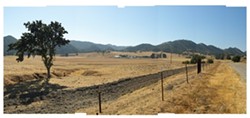Two different audiences. Two different messages.

- PHOTO BY STEVE E MILLER
- FORGOTTEN OIL FIELDS : a fledgling oil exploration company expects to succeed where other operations have failed in rural Huasna Valley, using new drilling techniques.
The Australian parent company of Excelaron LLC, the small oil exploration corporation that is proposing to tap long-dormant oil wells in Huasna Valley, is telling its shareholders information about the project that in some cases differs substantially from what Excelaron has told county planners and area landowners.
A New Times’ review of documents found the parent company’s communications have at times been more optimistic about both the status of the project and the quality of oil likely to be found. Even the amount of land in question varies between documents from the parent and those of its subsidiary.
Excelaron President Grant Jagelman, who also is the managing director of Australian Oil Company, Excelaron’s parent firm, denied the two companies are saying different things to different audiences. Exceleron did not make Jagelman available to respond to detailed questions.
In the first week of June 2007, San Luis Obispo-based Excelaron applied to the county for a series of permits to reestablish an abandoned oil operation in Huasna, east of Arroyo Grande.
Excelaron told county planners it intended to re-tap three existing wells that have been dormant since the 1980s. If that were not feasible, officials said in their application, they would drill as many as four new wells.
About a year later, the parent company, Australian Oil Company (AOC), which is listed on the Australian Securities Exchange, released a quarterly report to shareholders. In it, the group claimed “Further technical evaluation of the old wells has been carried out and as a result it has now been determined that we will initially drill three wells adjacent the old wells ;”
Stockholders, in other words, were being told definitively that new wells would be drilled based on an already complete “technical evaluation.”
The county, however, is still reviewing the company’s applications for oil exploration in Huasna. According to Excelaron, until the wells are physically explored, no one can know for sure what kind of oil is down there, or how much.
It’s not even known whether the county will deliver a “negative declaration” for the company’s exploration plans or demand a more stringent Environmental Impact Report.
Even if no EIR will be required, Excelaron would probably not be given permits until next year to begin physical exploration. Planner Carol Florence of Oasis Associates, which is representing Excelaron, said that if all goes smoothly, the issue could go before the SLO County Planning Commission in December.
Excelaron’s Operations Coordinator, Kit Matlik, said he could not speak for AOC, but emphasized that a “technical evaluation” refers broadly to such data as geological surveys of the area, computer-generated data, and historical information.
Excelaron staff acknowledged that no testing of wells can occur until the permits are in hand.
The AOC report further hints at a speedy process, telling of meetings with SLO county officials to accelerate the permitting process, and “commence drilling and production.”
In a subsequent report, released after June 30, AOC backtracked slightly, saying that further technical evaluations of the old wells were continuing. They concluded that they could not yet make a decision to re-enter old wells, or drill new ones.
But in that same report, the company may have overestimated the quality of oil to be had. The report stated that Excelaron intended to drill a test well that could “have potential lighter 32 API oil.”
The American Petroleum Institute (API) scale is a measure of petroleum gravity, whose numbers ascend as oil is lighter. Unrefined oil with a rating above 31.1 API is considered light crude.
When questioned about 32 API oil in the area, Excelaron staff said they would be surprised to find oil of such quality in Huasna. Historical records don’t support an expectation of such high-quality reserves in the area.
“We don’t have any of the 32 here on shore,” Florence said. “It’s just the nature of the geology.”
Yet another difference between what Excelaron has told local landowners and what AOC has told stockholders involves the amount of land under lease for the operation. A glossy, full-color information packet released by Excelaron states, twice, that the number of acres is around 250, but AOC reports to shareholders claim the area under lease is more than five times as large.
According to the Excelaron packet, which was handed out at a Sept. 18 meeting: “The project is limited to four exploration/production wells. Development will take place on only two parcels in Huasna Valley—on two acres out of a total of 259.76 acres.”
However, a report AOC released in July said, “During the quarter”—March 31 to June 30—“we have increased the area under lease to 1,275 acres and mineral rights owned to 75 acres for a total off 1,350 acres.”
Excelaron representatives would not disclose the owners of these leases.
Despite Excelaron’s efforts to reach out to the community through public forums, evidently the community remains opposed to the project. Jagelman was shown little sympathy when he addressed a tense, hostile crowd of Huasna Valley residents on Sept. 18.
“I don’t think we’re hearing the whole story here and it just doesn’t smell very good to me,” said Dennis Allan, an Arroyo Grande realtor.
Staff writer Colin Rigley contributed to this report. Kylie Mendonca can be reached at [email protected].
Comments